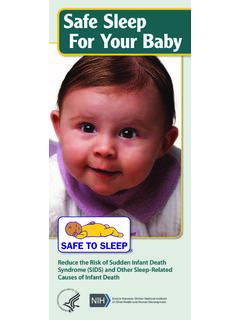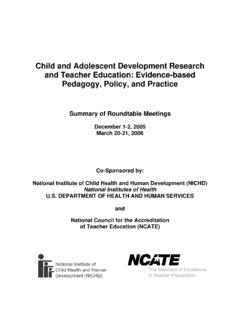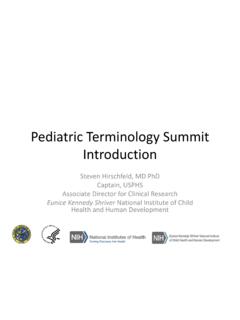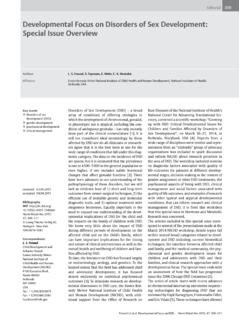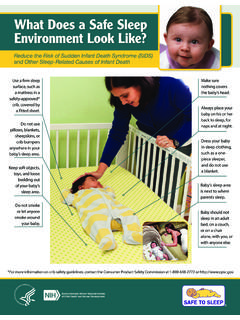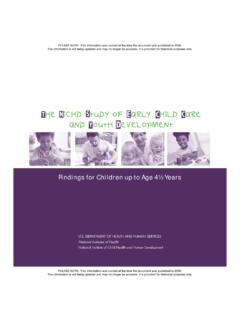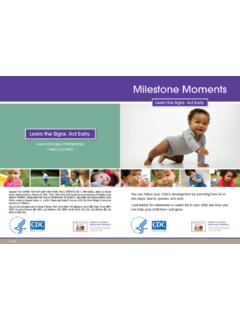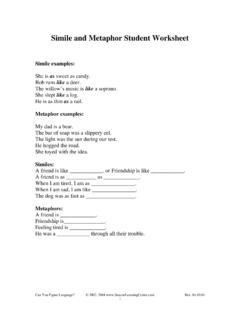Transcription of Safe Sleep for Your Baby - NICHD
1 SAFE SLEEPFOR YOUR BABYR educe the Risk of Sudden Infant Death Syndrome (SIDS) and Other Sleep -Related Causes of Infant DeathThis is what a safe Sleep environment looks like. The infant s Sleep area has no bumpers, pillows, blankets, or toys and is in the same room where the parents year in the United States, thousands of babies die suddenly and unexpectedly. Some of these deaths result from unknown causes, such as Sudden Infant Death Syndrome (SIDS), while others are from known causes, including other Sleep -related causes of infant is SIDS?SIDS is the sudden, unexpected death that doesn t have a known cause even after a full investigation of a baby between 1 month and 1 year of age.
2 About half of the sudden, unexpected infant deaths that occur in the United States each year are from are other Sleep -related causes of infant death?Other Sleep -related causes of infant death are those related to how or where a baby slept. These can include accidental: l Suffocation: when something, such as a pillow, or someone covers the baby s face and nose, blocking the ability to breathel Entrapment: when the baby gets trapped between two objects, such as a mattress and a wall, and can t breathel Strangulation: when something presses on or wraps around the baby s neck, blocking baby s airwayFast facts about SIDSl SIDS is the leading cause of death among babies 1 month to 1 year of age.
3 L Most SIDS deaths happen when babies are between 1 month and 4 months of should parents and caregivers know about SIDS and other Sleep -related causes of infant death?We have made great progress in reducing the 1990s, when the back-sleeping recommendations were first released and public awareness efforts began, the overall SIDS rate has dropped by about 60 percent. This lower rate equals thousands of babies lives. Since then, the number of babies placed on their backs to Sleep has tripled. But, as SIDS rates have declined, deaths from other Sleep -related causes, such as suffocation, have increased, and certain groups remain at higher risk for SIDS than others.
4 For example, African American and American Indian/Alaska Native babies are at higher risk for SIDS than white, Hispanic, or Asian/Pacific Islander babies. So there is still work to do to save infant lives. 3 Babies Sleep safest on their backs. Babies who Sleep on their backs are much less likely to die of SIDS than babies who Sleep on their stomachs or Sleep time counts. Babies should Sleep on their backs for naps and at night. Babies who are used to sleeping on their backs but who are then placed on their stomachs, like for a nap, are at very high risk for SIDS. Sleep surface and Sleep environment matter. Babies who Sleep on a soft surface, such as an adult mattress, or under a soft covering, such as a soft blanket or quilt, are more likely to die of SIDS or suffocation.
5 These deaths also are more likely when soft objects, toys, and blankets are in the baby s Sleep can I do to lower my baby s risk of SIDS and other Sleep -related causes of death?There is no sure way to prevent SIDS, but parents and caregivers can take steps to reduce the risk of SIDS and other Sleep -related causes of infant death:Always place baby on his or her back to Sleep , for naps and at night, to reduce the risk of back Sleep position is the safest position for all babies until they are 1 year old. Preemies (infants born preterm) should be placed on their backs to Sleep as soon as possible after birth. Babies who are used to sleeping on their backs, but who are then placed to Sleep on their stomachs, like for a nap, are at very high risk for baby rolls over on his or her own during Sleep from back to stomach or stomach to back, there is no need to reposition the baby .
6 Starting Sleep on the back is most important for reducing SIDS a firm and flat Sleep surface, such as a mattress in a safety-approved crib** A crib, bassinet, portable crib, or play yard that follows the safety standards of the Consumer Product Safety Commission (CPSC) is recommended. For information on crib safety, contact the CPSC at 1-800-638-2772 or , covered by a fitted sheet with no other bedding or soft items in the Sleep area. 6 Never place baby to Sleep on soft surfaces, such as on a couch, sofa, waterbed, pillow, quilt, sheepskin, or blanket . These surfaces can be very dangerous for babies. Do not use a car seat, stroller, swing, infant carrier, infant sling, or similar products as baby s regular Sleep area.
7 Following these recommendations reduces the risk of SIDS and death or injury from suffocation, entrapment, and your baby to reduce the risk of has many health benefits for mother and baby . Babies who breastfeed, or are fed breastmilk, are at lower risk for SIDS than babies who were never fed breastmilk. The longer a baby is exclusively breastfed or fed breastmilk, the lower the you bring baby into your bed for feeding, put him or her back in a separate Sleep area when finished. This Sleep area should be made for infants, like a crib or bassinet, and close to your bed. If you fall asleep while feeding or comforting baby in an adult bed, place him or her back in a separate Sleep area as soon as you wake up.
8 Evidence shows that the longer a parent and an infant bed-share, the higher the risk for Sleep -related causes of infant death, such as suffocation. Breastfeeding information is available at sharing reduces the risk for your room with baby . Keep baby in your room close to your bed, but on a separate surface designed for infants, ideally for baby s first year, but at least for the first 6 months. Room sharing reduces the risk of SIDS. baby should not Sleep in an adult bed, on a couch, or on a chair alone, with you, or with anyone else, including siblings or pets. Having a separate safe Sleep surface for the baby reduces the risk of SIDS and the chance of suffocation, strangulation, and entrapment.
9 If you bring your baby into your bed for feeding or comforting, remove all soft items and bedding from the area. When finished, put baby back in a separate Sleep area made for infants, like a crib or bassinet, and close to your bed. Couches and armchairs can also be very dangerous for babies, if adults fall asleep as they feed, comfort, or bond with baby while on these surfaces. Parents and other caregivers should be mindful of how tired they are during these times. There is no evidence for or against devices or products that claim to make bed sharing safer. Do not put soft objects, toys, crib bumpers, or loose bedding under baby , over baby , or anywhere in baby s Sleep these items out of baby s Sleep area reduces the risk of SIDS and suffocation, entrapment, and strangulation.
10 Because evidence does not support using them to prevent injury, crib bumpers are not recommended. Crib bumpers are linked to serious injuries and deaths from suffocation, entrapment, and strangulation. Keeping these and other soft objects out of baby s Sleep area is the best way to avoid these not smoke during pregnancy, and do not smoke or allow smoking around your baby or in your baby s reduce the risk of SIDS, women should:Get regular prenatal care during smoking, drinking alcohol, and using marijuana and illegal drugs during pregnancy and after the baby is about giving your baby a pacifier for naps and nighttime Sleep to reduce the risk of not attach the pacifier to anything like a string, clothing, stuffed toy, or blanket that carries a risk for suffocation, choking, or strangulation.
